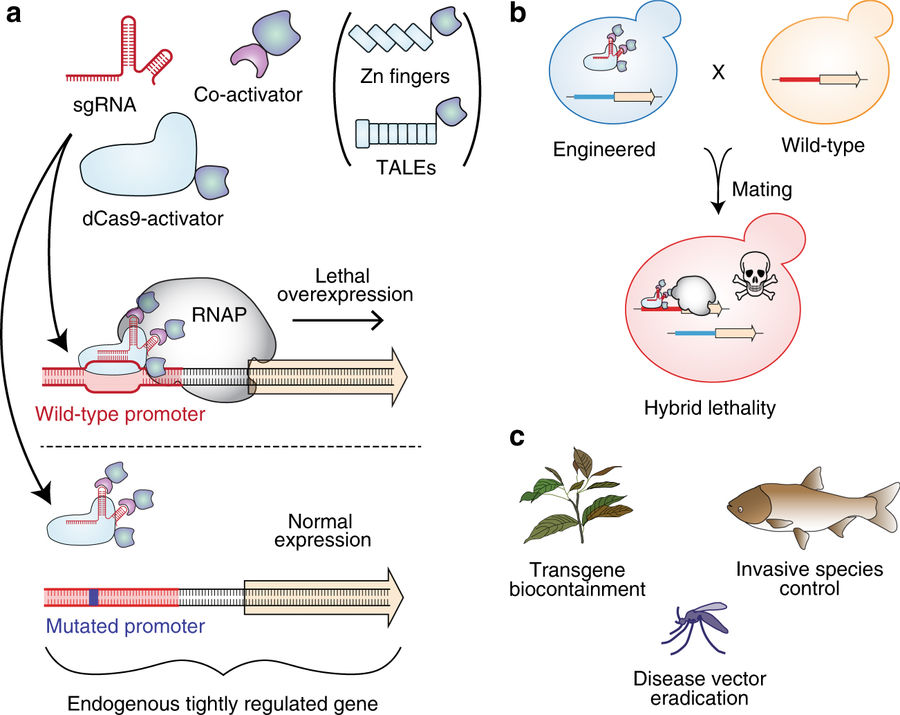Biotechnologists have engineered a genetic barrier to sexual reproduction between otherwise compatible populations. The barrier is called synthetic incompatibility. It depends on programmable transcription factors and works something like a kill switch, one slipped into the genetic code of a sexually reproducing organism. When the organism produces hybrid offspring, this kill switch may activate genes that cause the offspring to die.
This synthetic incompatibility has been developed by scientists based at the University of Minnesota. They report that their approach works in yeast, and they are looking forward to testing their technology in other organisms.
“We're working on moving into model fish, insects, nematodes, and plants,” said Michael Smanski, Ph.D., an assistant professor who led the yeast study, which appeared October 12 in the journal Nature Communications. The study, entitled “Engineering Species-Like Barriers to Sexual Reproduction,” suggests that synthetic incompatibility could be used in agricultural applications, the eradication of disease vectors, the control of invasive species, and the safe study of emerging biotechnology applications.
The paper notes that various approaches have been used to engineer species-like barriers between otherwise compatible populations. For example, many of these approaches are based on the sterile insect technique, which functions by releasing radiation- or chemically sterilized males to nonproductively mate with wild-type females. Although such approaches are promising, they may also require continuous release to prevent reintroduction, should they fail to drive target populations to extinction.
Synthetic incompatibility technology, which uses programmable transcription factors to engineer species-like barriers to sexual reproduction, has been tested in yeast, as shown by these live-cell imaging videos. Offspring from wild-type yeast (left) grow and divide to form a microcolony. Hybrid offspring between wild-type and a “synthetic incompatibility” strain (right) are not viable. [Smanski Lab/University of Minnesota]
The authors of the current study suggest that synthetic species-like barriers hold promise as an approach to confine gene-drive systems and as a method to replace disease-vectoring populations of insects with nonvectoring insects.
“As a proof of concept, we target the ACT1 promoter of the model organism Saccharomyces cerevisiae using a dCas9-based transcriptional activator,” wrote the article’s authors. “Lethal overexpression of actin results from mating this engineered strain with a strain containing the wild-type ACT1 promoter.”
“Recently developed CRISPR-Cas9 based technologies should make it possible to apply synthetic incompatibility in a broad variety of sexually reproductive organisms,” they continued. “Recombination events between the target and mutant loci likely triggered by dCas9 binding indicate that applying this technology in higher organisms will require expressing dCas9 activators only in multicellular stages of life so that it is unlikely enough cells undergo recombination to rescue the whole organism.”
A major obstacle to applying genetic engineering to benefit humans and the environment is the risk that organisms whose genes have been altered might produce offspring with their natural counterparts, releasing the novel genes into the wild. Now, the research team led by Dr. Smanski propose that their approach could effectively make engineered organisms a separate species that is unable to produce viable offspring with their wild or domesticated relatives.
The technology uses programmable transcription factors that make it possible to control which genes are turned on and which genes are turned off in an organism. If an engineered organism mates with a wild counterpart, the transcription factors render the offspring unable to survive by activating genes that cause their cells to die.
“This approach is particularly valuable because we do not introduce any toxic genes,” explained Maciej Maselko, Ph.D., a postdoctoral scholar from Dr. Smanski's lab who performed the work. “The genetic incompatibility results from genes already in the organism being turned on at the wrong place or time.”
“Other methods to control gene flow, for example disrupting pollen or using a chemical to control reproduction in crops, are very species-specific and change how the crops are propagated. Our approach is expected work in virtually any sexually reproducing organism without changing how they are normally grown,” added Dr. Smanski.
Synthetic incompatibility may make it possible to use crops to produce medications as well as food, feed, and fuel. It also raises hope for using genetic engineering to control populations of invasive species or pests, such as Asian carp in North America and disease-carrying mosquitoes throughout the world.
“We have presented the proof of concept for a, to the best of our knowledge, new approach to introducing defined genetic barriers to sexual reproduction,” the authors of the Nature Communications article concluded. “Applying synthetic incompatibility to crops engineered to make biofuels or pharmaceuticals may allow for broader cultivation while preventing transgene flow to wild relatives or varieties used for human consumption.”






